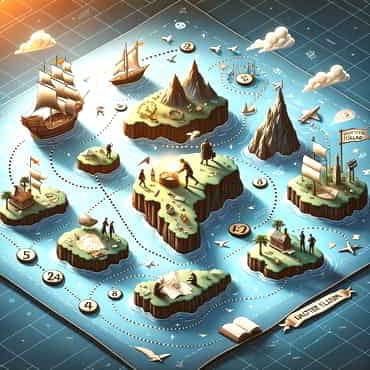Goal Setting And Task Prioritisation: Specific Activities And Outcomes

Estimated reading time: 6 Min
In this guide we explore goal setting and task prioritisation. Choosing specific activities and outcomes. Precision and clarity are important.
Here’s yet another sailing metaphor!
Imagine setting sail on the vast ocean without a chart or compass; even if you’re an accomplished sailor, once you’ve left sight of land, you might find yourself adrift in a sea of confusion and inefficiency.
This is the predicament many of us face in a bustling daily life without goal-setting and task-prioritisation.
Why? You ask.
Charting a course through the unpredictable waves of our personal and professional responsibilities requires more than just a sturdy ship and some sailing skill; it demands a clear destination and a well-thought-out route.
So, in this guide, we embark on a voyage to explore the art of defining achievable goals and organising tasks with the precision of a seasoned captain navigating through the fog. I also included a few activities (exercises) for your action.
So hoist your sails and let’s plot a course towards success, where the treasure map is your own set of well-crafted goals and the X marks the spot of your ultimate achievements.
That’s enough about sailing; now let’s move on to goal-setting.
The Science and Art of Goal Setting
The psychological framework behind goal-setting is empowering.
Studies have shown that setting specific, challenging goals leads to higher performance 98% of the time compared to easy or do-your-best goals.
It’s the mental equivalent of setting your sights on a distant, treasure island rather than just aiming to sail in the right direction.
SMARTER goals
SMARTER goals are specific, measurable, achievable, relevant, time-bound, environmentally aware, and resourced.
For instance, saying “I want to write a novel” is like wishing to explore the Seven Seas. Refining it to “I will write a 70,000-word fantasy novel by December next year” is akin to marking a precise island on your map where the treasure awaits.
Activity:
Take a moment to draft your own SMARTER goal. You could picture the exercise as setting coordinates for your ship’s next grand adventure.
Understanding Task Prioritisation
Working your way through the day’s tasks requires more than just a keen sense of direction; it demands an understanding of what deserves your immediate attention and what can wait.
Enter the Eisenhower Matrix
A chart that helps distinguish between tasks that are urgent, important, both, or neither.
Imagine your tasks as various islands, some with hidden treasures (important tasks) and others with sirens calling you to veer off course (urgent but not important tasks).
The Eisenhower Matrix helps you navigate these waters, ensuring you reach the most valuable destinations first.
Pareto Principle
Otherwise known as the 80/20 rule, which suggests that 80% of results come from 20% of efforts.
This might be an exercise in finding the most fertile fishing grounds that promise the best catch with the least effort.
Activity:
List your daily tasks and categorise them using the Eisenhower Matrix. It’s like charting your course for the day, ensuring you sail towards what truly matters.
Strategies for Effective Goal Achievement

Reaching your destination at any distance requires more than just setting a course; it involves breaking down your goals into actionable steps and establishing routines that ensure steady progress.
In effect, it’s like plotting a series of short voyages, perhaps island hopping, that ultimately lead to your treasure island.
Breaking down goals
Breaking goals down into actionable steps is like dividing your chart into sectors and conquering each one before moving on to the next.
It’s both a strategy for navigation and a way to measure progress.
The power of habit formation
Just as a ship benefits from the steady rhythm of the waves to help carry it along, your journey towards your goals thrives on the consistency of your habits. Whether it’s writing 500 words a day or practicing an instrument for an hour, these habits are like the repetitive waves that help propel your ship forward.
Activity:
Create a habit tracker related to your SMARTER goal. Monitor your progress like a captain logs their journey, noting the winds and waves that favour you, those that don’t, the storms you weather, and anything you learn.
By now, you should feel like the captain of your own destiny, navigating through the seas of goal-setting and task prioritisation with confidence.
Remember, though, that every great voyage begins with the courage to set sail.
Overcoming Obstacles in Goal Setting and Task Prioritisation
Charting a course towards your goals is not without its storms.
The seas of life are peppered with islands of procrastination, whirlpools of perfectionism, and the occasional kraken of overwhelm.
Navigating these challenges requires a blend of cunning, courage, and a bit of old-fashioned seafaring grit.
Common pitfalls
Procrastination is the siren call that lures many sailors off course, whispering, “Why sail today when the winds might be fairer tomorrow?”
Perfectionism, on the other hand, is the pursuit of the mythical perfect wind; awaiting its arrival can prevent a ship from ever leaving harbour.
Overwhelm is the storm that darkens the skies, making it hard to see the stars by which we navigate.
Solutions and techniques
To combat procrastination, set sail with small tasks; the momentum of the beginning can carry you forward.
Against perfectionism, remember that a voyage completed with a few detours is better than never departing.
When faced with overwhelm, chart a course through calmer waters by breaking down tasks into manageable chunks.
Case study
Consider the journey of Sir Ernest Shackleton, whose Antarctic expedition faced unimaginable obstacles.
His leadership, focusing on one challenge at a time and maintaining morale against all odds, serves as a beacon for us all.
Activity:
Identify one personal obstacle that has been limiting your productivity. Figure out some strategies to navigate around this obstacle, ensuring smooth sailing ahead.
Tools and Resources for Goal Setting and Task Management
In the age of digital navigation, we have more tools at our disposal than the compass and sextant.
However, the old ways still hold their charm and utility, offering a tactile sense of direction that modern devices cannot replicate.
Digital tools and apps
Like the modern GPS, guiding us through the most efficient routes to achieve our goals. Apps such as Trello, Asana, and Notion serve as our digital life and business quartermasters, keeping our tasks and goals well-organised.
Traditional methods
There’s something about plotting your course on a physical chart that feels profoundly satisfying. Vision boards can serve as your personal constellation of goals, guiding you like the North Star.
Pro tip
Combine the digital with the traditional for a balanced approach. Use apps to manage your tasks day-to-day, but let a physical journal or vision board remind you of the bigger picture.
Activity:
Try using one digital tool and one traditional method for a week. Note which one helps you feel more connected to your goals and why.
Summary
Remember that although the art of goal setting and task prioritisation is about reaching your destination, it’s also about enjoying the voyage, learning from the challenges, and growing stronger with each wave conquered.
Whether you’re a seasoned sailor of the productivity seas or just setting out, remember that every great adventure begins with the courage to set sail.
May you do all you can to pick the best winds, and constantly use your chart and compass to ensure you continue in the optimum direction towards your destination.
Now, I invite you to share your own voyages in goal setting and task prioritisation.
What seas have you sailed?
What storms have you weathered?
Like sailors of old, let’s share our log books and learn from each other’s charts, for in the vast ocean of life, no sailor is alone.
🙂
Richard






